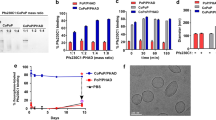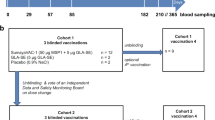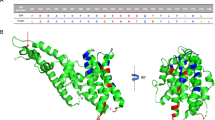Abstract
Research towards the development of a vaccine against malaria has recently accelerated1, mainly because of a resurgence in the worldwide incidence of the disease2. These investigations have been aided by the use of the owl monkey for direct experimentation with human malaria3–5, techniques for producing Plasmodium falciparum antigen through continuous or shortterm in-vitro cultivation6,7, and the recent demonstration of effective immunization of owl monkeys against P. falciparum 8,9. However, the inclusion of a strong adjuvant in the vaccines seems to be required for the development of protective immunity. Thus, inclusion of the whole mycobacterial cell wall/mineral oil adjuvant (Freund's complete adjuvant: FCA)8,9 or a semi-synthetic derivative of the active component of that cell wall (6-O-stearoyl-N-acetylmuramyl-L-alanyl-D-iso-glutamine: stearoyl-MDP)10,11 has been necessary for the successful immunization of primates against P. falciparum. The use of X-ray irradiated parasites12–14 or substitution of FCA by muramyl-dipeptide15,16 does not result in significant protective immunity. Because the systemic and local toxic responses to the active adjuvants is either unacceptable (as in the case of FCA)10,11, or essentially undescribed (as for stearoyl-MDP), it seemed highly desirable to attempt to identify alternative, well tolerated synthetic compounds with strong adjuvant activity for malarial vaccines. A potential candidate for this role was CP-20,961 (N,N-dioctadecyl-N′,N′-bis (2-hydroxyethyl)-propanediamine), a synthetic lipoidal amine, originally characterized as an interferon inducer17–20, with strong adjuvant activity for humoral and cellular immune responses21,22. We now report that killed P. falciparum merozoite antigen administered with CP-20,961 can effectively immunize owl monkeys against a lethal P. falciparum infection.
This is a preview of subscription content, access via your institution
Access options
Subscribe to this journal
Receive 51 print issues and online access
$199.00 per year
only $3.90 per issue
Buy this article
- Purchase on Springer Link
- Instant access to full article PDF
Prices may be subject to local taxes which are calculated during checkout
Similar content being viewed by others
References
WHO tech Rep. Ser. 579 (World Health Organization, Geneva, 1975).
Maugh, T. H. Science 196, 413–416 (1977).
Young, M. D., Porter, J. A. Jr & Johnson, C. M. Science 153, 1006–1007 (1966).
Geiman, Q. M. & Meager, M. J. Nature 215, 437–439 (1967).
Geiman, Q. M. & Siddiqui, W. A. Am. J. trop. Med. Hyg. 18, 351–354 (1969).
Trager, W. & Jensen, J. B. Science 193, 673–675 (1976).
Siddiqui, W. A., Schnell, J. V. & Richmond-Crum, S. Am. J. trop. Med. Hyg. 23, 1015–1018 (1974).
Siddiqui, W. A. Science 197, 388–389 (1977).
Mitchell, G. H., Butcher, G. A., Richards, W. H. G. & Cohen, S. Lancet ii, 1335–1338 (1977).
Kotani, S. et al. Biken's J. 20, 95–103 (1977).
Siddiqui, W. A., et al. Science 201, 1237–1239 (1978).
Voller, A. & Richards, W. H. G. Lancet ii, 1172–1174 (1968).
Sadun, E. H., Wellde, B. T. & Hickman, R. L. Milit. Med. 134, 1165–1175 (1969).
Wellde, B. T., Diggs, C. L. & Anderson, S. Bull. Wld Hlth Org. 57, Suppl. 1, 153–157 (1979).
Siddiqui, W. A. et al. Bull. Wld Hlth Org. 57, Suppl. 1, 199–203 (1979).
Reese, R. T., Trager, W., Jensen, J. B., Miller, D. R. & Tantravati, R. Proc. natn. Acad. Sci. U.S.A. 75, 5665–5668 (1978).
Hoffman, W. W., Korst, J. J., Niblack, J. F. & Cronin, T. H. Antimicrob. Ag. Chemother. 3, 498–502 (1973).
Glaz, E. T. & Talas, M. Acta microbiol. acad. sci. hung. 25, 87–96 (1978).
Panusarn, C., Stanley, E. D., Dirda, V., Rubenis, M. & Jackson, G. G. New Engl. J. Med. 291, 57–61 (1974).
Niblack, J. F. Tex. Rep. Biol. Med. 35, 528–534 (1977).
Niblack, J. F. et al. J. reticuloendothel. Soc. S26, 655–666 (1979).
Chang, Y. H. & Pearson, C. M. Arthritis Rheum. 21, 169–170 (1978).
Anderson, A. O. & Reynolds, J. A. J. reticuloendothel. Soc. S26, 667–680 (1979).
Siddiqui, W. A. & Schnell, J. V. J. Parasit. 59, 516–519 (1973).
Siddiqui, W. A. & Richmond-Crum, S. M. J. Parasit. 63, 583–584 (1977).
Siddiqui, W. A., Kramer, K. & Richmond-Crum, S. M. J. Parasit. 64, 168–169 (1978).
Inoue, K. Biochim. biophys. Acta 339, 390–402 (1974).
Ma, N. S. F., Jones, T. C., Miller, A. C., Morgan, L. M. & Adams, E. A. Lab. Anim. Sci. 26, 1022–1036 (1976).
Moorehead, B. S., Nowell, P. C., Mellman, W. J., Battips, D. M. & Hungerford, D. A. Expl Cell Res. 20, 613–616 (1960).
Taylor, W. & Siddiqui, W. A. J. Parasit. 65, 267–271 (1979).
Author information
Authors and Affiliations
Rights and permissions
About this article
Cite this article
Siddiqui, W., Kan, SC., Kramer, K. et al. Use of a synthetic adjuvant in an effective vaccination of monkeys against malaria. Nature 289, 64–66 (1981). https://doi.org/10.1038/289064a0
Received:
Accepted:
Issue Date:
DOI: https://doi.org/10.1038/289064a0
This article is cited by
-
Plasmodium falciparum antigens as target molecules for a protective immunization against malaria: an up-to-date review
Zeitschrift f�r Parasitenkunde Parasitology Research (1986)
-
Malaria vaccine protects offspring
Nature (1981)
Comments
By submitting a comment you agree to abide by our Terms and Community Guidelines. If you find something abusive or that does not comply with our terms or guidelines please flag it as inappropriate.



